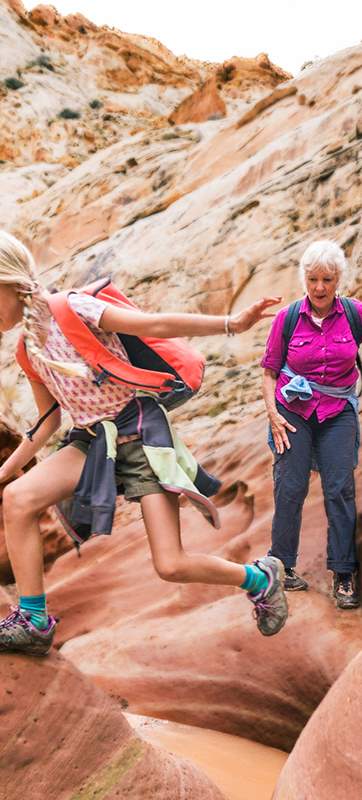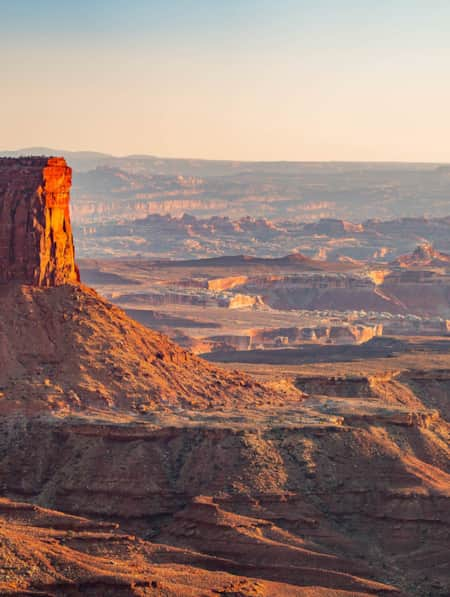
Little Wild Horse & Ding and Dang
The Little Wild Horse trailhead is located five miles west of the Goblin Valley State Park Visitor Center along an improved dirt road, aptly named Little Wild Horse Road. There are signs at the trailhead parking lot to help you find the correct starting point. An initial scramble near the canyon’s entrance may feel difficult for beginners and families with children, but it’s doable for most hikers, especially if a taller member of the party is willing to lend a boost to the others. This is about as tricky as the canyon gets, so if you can make it through here, you’re good to go.
You’ll encounter near-endless rock formations and swirls along the eight-mile course. Whether you have kids or are still a kid at heart, you will have a blast creatively shimmying and winding through the canyon’s narrow slots. Occasionally, the canyon will open up wider to offer a little extra breathing room.
About halfway through, you’ll get to the top of Little Wild Horse and must decide whether you want to return the way you came or form a loop by following a dirt road toward the top of Bell Canyon, a lovely, but much less complex canyon, than the one you came up.
If you’re ready to tackle Ding and Dang Canyons, it’s shorter mileage-wise at about five miles (if you make the full loop), but more difficult in its navigation. You’ll head about 1.3 miles past the Little Wild Horse trailhead and park in the small parking area.
While some obstacles in this slot canyon may seem difficult to overcome, you can generally problem solve by just stepping back for a moment and thinking carefully.
Occasionally you’ll find some water in these narrows, so you might want to wear shoes you can wade in. It’s rarely deep unless it’s very recently rained heavily, and if it has, you probably shouldn’t be out there anyway because of the chance of dangerous flash flooding.
Once you get to the top of Ding Canyon, follow a faint trail west over a small rise between the reef and Ding Dang Dome, then start dropping into Dang Canyon, heading downstream. Some downclimbing can be required, but none of it is too difficult, especially if you make good use of ledges and stemming opportunities. You’ll eventually emerge from Dang and simply follow the wash another 1.5 miles to return to your original parking area.
As a word of caution, only attempt these canyons if you have plenty of water, a topographic map, and good map reading skills. You also need to make sure there is no risk of flash flooding. Agile kids usually do just fine in Little Wild Horse (indeed, it’s a giant prehistoric playground), but Ding and Dang may be a bit too much for the pint-sized crowd. Serious adventurers may consider hiring a guide to explore these beautiful, remote areas even more thoroughly, and with confidence.
GPS Coordinates: 38.583856, -110.802598
You’ll encounter near-endless rock formations and swirls along the eight-mile course. Whether you have kids or are still a kid at heart, you will have a blast creatively shimmying and winding through the canyon’s narrow slots. Occasionally, the canyon will open up wider to offer a little extra breathing room.
About halfway through, you’ll get to the top of Little Wild Horse and must decide whether you want to return the way you came or form a loop by following a dirt road toward the top of Bell Canyon, a lovely, but much less complex canyon, than the one you came up.
If you’re ready to tackle Ding and Dang Canyons, it’s shorter mileage-wise at about five miles (if you make the full loop), but more difficult in its navigation. You’ll head about 1.3 miles past the Little Wild Horse trailhead and park in the small parking area.
While some obstacles in this slot canyon may seem difficult to overcome, you can generally problem solve by just stepping back for a moment and thinking carefully.
Occasionally you’ll find some water in these narrows, so you might want to wear shoes you can wade in. It’s rarely deep unless it’s very recently rained heavily, and if it has, you probably shouldn’t be out there anyway because of the chance of dangerous flash flooding.
Once you get to the top of Ding Canyon, follow a faint trail west over a small rise between the reef and Ding Dang Dome, then start dropping into Dang Canyon, heading downstream. Some downclimbing can be required, but none of it is too difficult, especially if you make good use of ledges and stemming opportunities. You’ll eventually emerge from Dang and simply follow the wash another 1.5 miles to return to your original parking area.
As a word of caution, only attempt these canyons if you have plenty of water, a topographic map, and good map reading skills. You also need to make sure there is no risk of flash flooding. Agile kids usually do just fine in Little Wild Horse (indeed, it’s a giant prehistoric playground), but Ding and Dang may be a bit too much for the pint-sized crowd. Serious adventurers may consider hiring a guide to explore these beautiful, remote areas even more thoroughly, and with confidence.
GPS Coordinates: 38.583856, -110.802598



